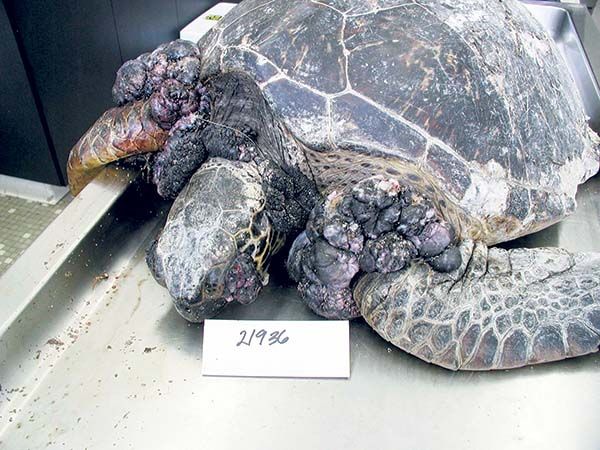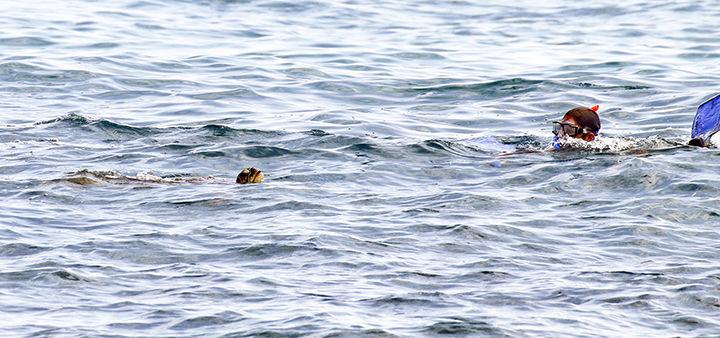LIHUE — If you’ve spent significant time in the ocean, you’ve probably seen it for yourself. For decades, Hawaii’s green sea turtles, along with marine turtles around the globe, have suffered from grotesque, deadly cancer-like tumors caused by a viral
LIHUE — If you’ve spent significant time in the ocean, you’ve probably seen it for yourself.
For decades, Hawaii’s green sea turtles, along with marine turtles around the globe, have suffered from grotesque, deadly cancer-like tumors caused by a viral disease called fibropapillomatosis (FP).
And recently, scientists linked the disease — the leading cause of death in endangered green sea turtles — to land-based pollution.
The tumors are caused by consuming non-native algae, dubbed “superweeds,” along coastlines where nutrient pollution is unchecked, according to new research published Sept. 30 in the scientific journal PeerJ.
While scientists focused on sites around Oahu and Maui, the Garden Isle is also home to diseased turtles.
“You definitely have it in Kauai, I’ve seen it,” said Dr. Thierry Work, a wildlife disease specialist for the U.S. Geological Survey.
In fact, he recently conducted a necropsy on an afflicted Kauai turtle.
Work described FP as a “nasty disease,” with tumors varying in size and found both externally and internally. Larger tumors can impact a turtle’s ability to see, swim, eat and even breath.
“Turtles affected with FP typically get tumors on the skin of the flippers and neck, eyes, corners of the mouth, cloaca, and internal organs,” Work and George Balazs, head of the Marine Turtle Research Program at the National Oceanic and Atmospheric Administration’s Pacific Islands Fisheries Science Center, wrote in a fall 2013 paper entitled “Tumors in Sea Turtles.”
Turtles that graze on blooms of invasive seaweeds end up with a diet that is rich in a particular amino acid, arginine, which promotes the virus that creates the tumors, according to a University of Hawaii release about the new research. Scientists at UH Manoa and NOAA estimate that adult turtles foraging at high-nutrient grazing sites increase their arginine intake 17–26 grams daily, up to 14 times the background level.
“For years, local ocean lovers have known that our green turtles have had awful tumors on their heads, eyes and front flippers,” UH Manoa Botany Professor Celia Smith, who worked with Kyle S. Van Houton of NOAA’s Turtle Research Program on the study, said in a release. “Many hypotheses were offered to explain the tumors, but we kept coming back to the observation that urban reefs — those near dense populations — are the sites with greater numbers of sick turtles. We had no mechanism for this disease.”
More than 60 percent of turtles in Kaneohe Bay have been observed with tumors, the release states. And Kihei, Maui has been called a “ground zero” for FP, which is caused by a herpes virus and manifests as tumors. Humans appear unaffected by the disease.
Don Heacock, a fisheries biologist with the state Department of Land and Natural Resources on Kauai, said that while diseased turtles are found around Kauai, the numbers have declined in recent years. He estimates Kauai’s turtle population has between a 1- and 2-percent infection rate.
“Where we do see a lot of them is at the Old Koloa Landing,” where Waikomo Stream discharges into the ocean in Poipu, he said.
Tara Leota, a local marine biologist and snorkel tour captain at Kauai Sea Rider Adventure Tours, agreed that the area near Waikomo has higher numbers.
“A couple of times a week I will see a turtle with tumors, in different locations but predominantly in Poipu and areas with heavy runoff,” she said.
Leota recognizes that green sea turtles can travel between the islands, and that seeing a diseased turtle in Poipu doesn’t necessary mean it got sick in that location. She also said that the recent findings linking the disease to land-based pollution came as no surprise.
“It’s kind of what I’d always assumed,” she said.
Work points out that while FP is hideous and sometimes deadly, there has been a positive shift in prevalence.
“The bottom line is the disease is declining, and it has been since the mid-90s,” he said.
After peaking around 50 percent, it has since declined to less than 20 percent.
In their paper, published in The Wildlife Professional, Work and Balazs wrote that as coastal ecosystems continue to degrade, it is likely that FP will continue to plague sea turtles.
“The visibility of the disease in these charismatic animals invariably prompts public concern, one reason why researchers must strive to learn what is driving the illness,” they wrote. “In the case of FP, we may ultimately come to find that prevention and cure lie in proper treatment of wastewater and agricultural and storm runoff. Discovering the cause of FP in sea turtles and addressing that cause may therefore lead to more responsible development and cleaner oceans for all marine life.”
•••
Chris D’Angelo, environment writer, can be reached at 245-0441 or cdangelo@thegardenisland.com.



